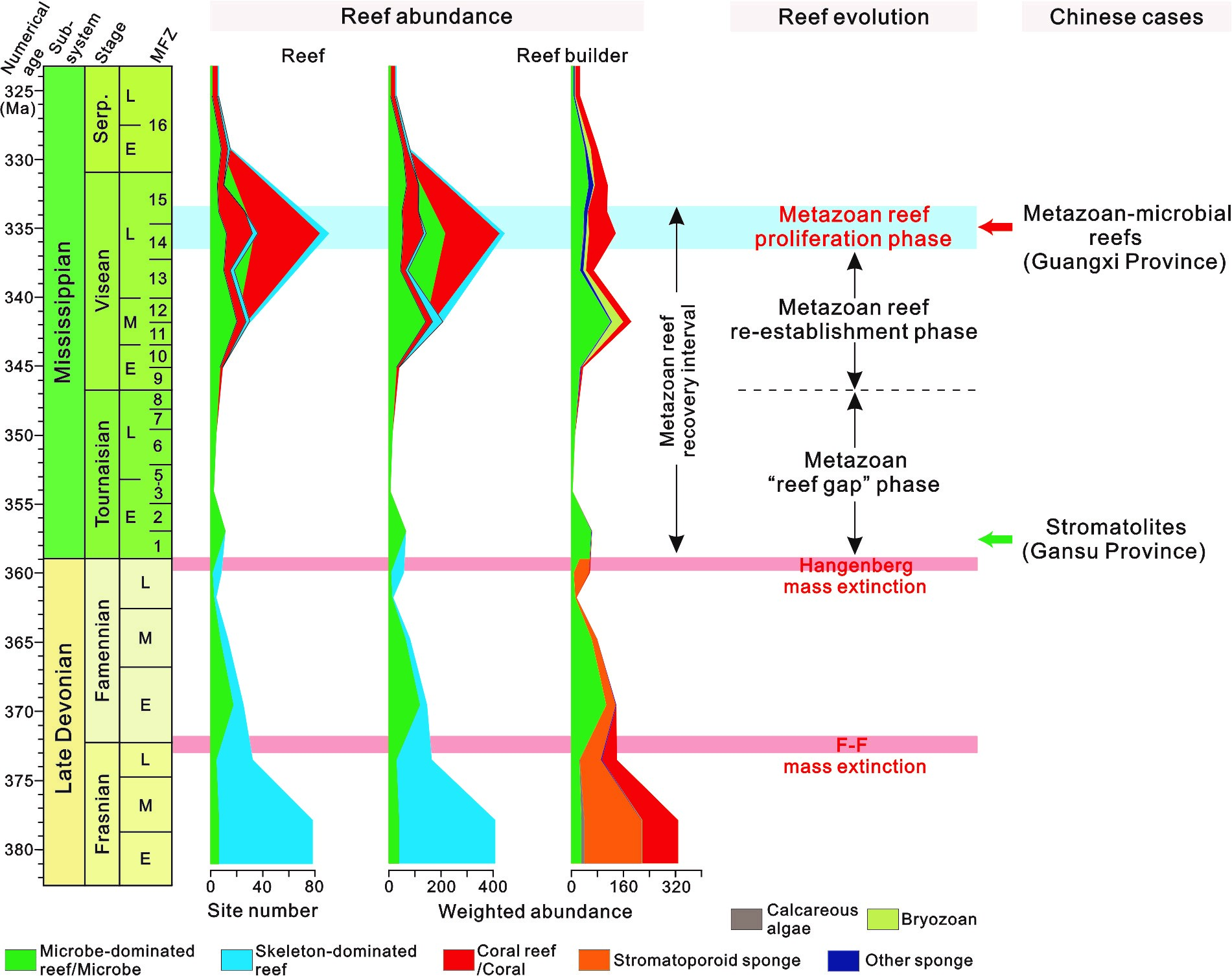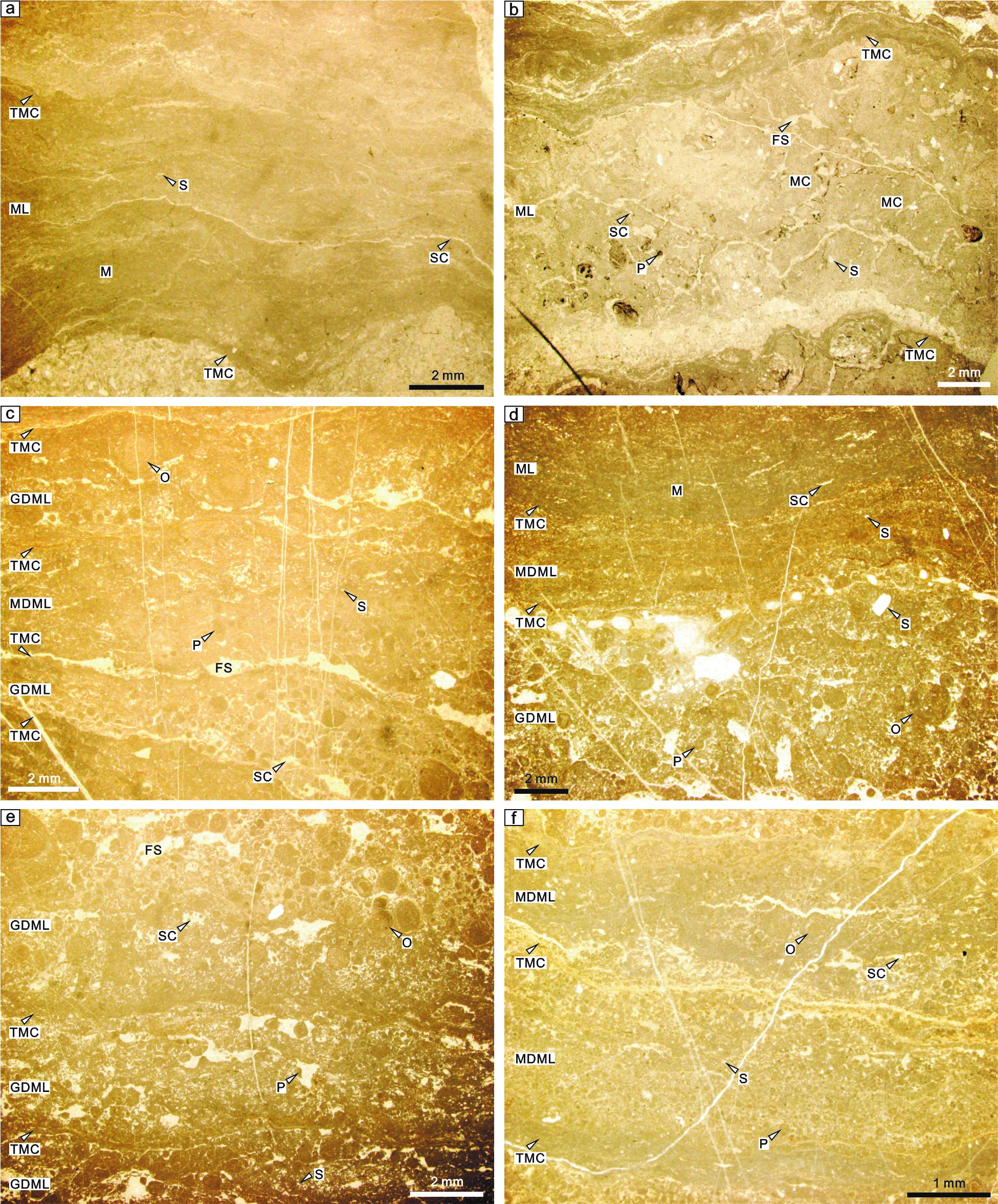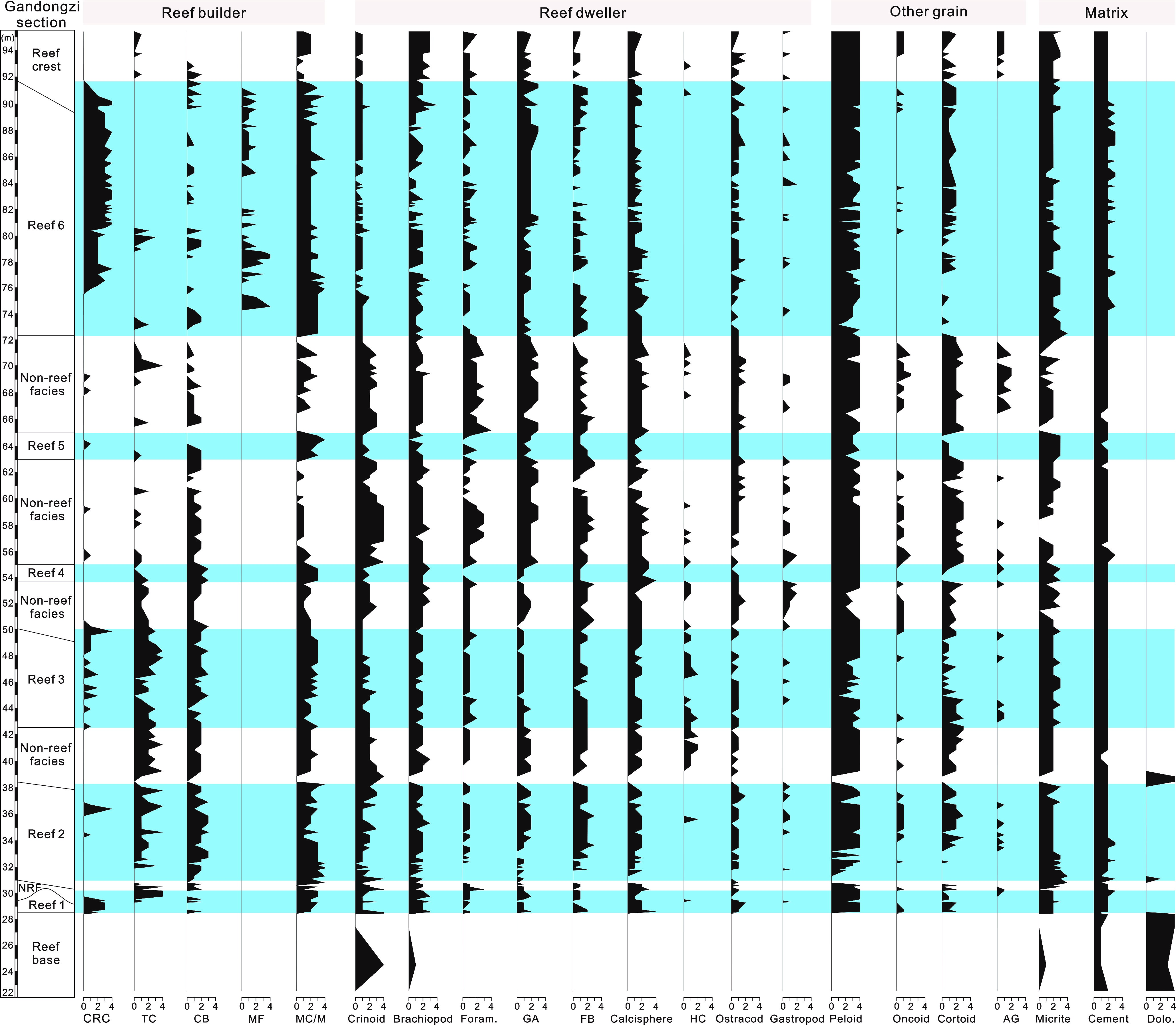During the Middle-Late Devonian, the largest area of metazoan (stromatoporoid-coral) reefs of the Phanerozoic occurred, which covered about five million square kilometres (10 times the surface area of modern reef ecosystems). The Late Devonian Frasnian-Famennian (F-F) Kellwasser and the end-Devonian Hangenberg extinctions caused the collapse and disappearance of stromatoporoid-coral ecosystems, respectively. The succeeding Mississippian has long been assumed to be an interval dominated by microbial reefs, and was lack of metazoan reefs. To date, it is still unclear about the Mississippian reef evolutionary pattern and its comparison between different palaeocontinents.
Associated Prof. YAO Le from the Nanjing Institute of Geology and Palaeontology, Chinese Academy of Sciences (NIGPAS), cooperated with Associated Prof. Markus Aretz from the University of Toulouse 3 for a long period. They have conducted detail studies on the reef ecosystem evolutions across the Late Devonian mass extinction transition, and achieved a series of findings. Relevant findings were published in international journals of Earth-Science Reviews, Palaeogeography, Palaeoclimatology, Palaeoecology, and Geological Journal.
Based on the systematic evaluation and study on the Late Devonian to Mississippian reefs, three sub-intervals of the Mississippian metazoan reef recovery were distinguished, which are, first metazoan “reef gap” phase (MRG) without metazoan reefs during the Tournaisian; second metazoan reef re-establishment phase (MRR) containing a few metazoan reefs from early Visean to early part of the late Visean; and third metazoan reef proliferation phase (MRP) with global coral reef flourishment during the middle part of the late Visean (late Asbian to early Brigantian substages) (Yao et al., 2020a).
In order to uncover whether the Mississippian reef evolutionary pattern of China is consistent with that of globe, associated Prof. YAO Le and his collaborators have studied the stromatolites from the Qianheishan Formation in the Dashuigou section in Pingchuan County, Gansu Province, and the metazoan-microbial reefs from the Du’an Formation in the Dashuigou section in Tianlin County, Guangxi Province.
The Dashuigou stromatolites are exposed of about 22.5 m in thickness, which can be traced laterally more than 200 m. Based on the ammonoid, ostracod and palynological fossils, the stromatolites age is constrained to the earliest Carboniferous (conodont zone of Lower Siphonodella sulcate). Three stromatolite morphology types could be distinguished in field, which are laminar, wavy-laminar and domal forms. They consist mainly of micrite, peloids, oncoids, silt-sized quartz grains and sparry calcite with rare fine to coarse quartz grains and bioclasts. Three types of stromatolite laminae were distinguished, including micritic laminae, grain-dominated mixed laminae and micrite-dominated mixed laminae. These laminae are separated by thin micritic crusts and form two lamination styles of repetitive lamination and alternating lamination. The development of grain-rich and micrite-rich laminae in the stromatolites implies that they were formed by the combination of microbial baffling, binding, and calcification. Facies analysis suggests that the stromatolites developed during a gradually relative sea-level rise, and demise was triggered by dramatic relative sea-level fall with enhanced siliciclastic inputs (Yao et al., 2020b).
The Gandongzi metazoan-microbial reefs range in size from several metres to tens of metres, which contain positive reliefs. Foraminiferal fossils constrain the reef age belonging to the late Visean (Mississippian foraminiferal zone (MFZ) 14 to MFZ 15). According to field observation and quantitative studies of biotic composition in thin sections, four different reef types were identified which are coral reef, coral-microbial-microproblematica-bryozoan reef, coral-microbial-bryozoan reef, and microbial-bryozoan-coral reef. These reefs are constructed primarily of different proportion of colonial rugose corals (Diphyphyllum and Siphonodendron), tabulate corals (Multithecopora and Syringopora), cystoporate bryozoans (Fistulipora), and calcimicrobes (e.g., Garwoodia and Renalcis). Facies analysis reveals a variable composition, including framestone and bindstone in reef facies, and rudstone, grainstone, packstone, dolomitic crinoidal packstone and dolostone in the strata intercalated with reefs. Relative sea-level changes controlled the growth and demise of the Gandongzi reefs. They commonly grew during relative sea-level rise and died during relative sea-level fall, as evident from increasing and decreasing abundance of micrite, and decreasing and increasing abundance of cortoids, green algae and sparry calcite in reefs and their overlying strata, respectively. The Gandongzi reefs resemble coeval similar reef types on other palaeocontinents, in terms of reef-builder composition and internal structures, especially for the extensive development of coral framework building (Yao and Aretz, 2020).
The occurrences of the early Tournaisian stromatolites and late Visean coral reefs in China, correspond to the MRG and MRP intervals respectively, which suggest that the Mississippian reef evolutionary pattern in China is consistent with that of globe after the Late Devonian mass extinctions.
Profs. CHEN Jitao and QI Yuping from NIGPAS, Prof. Paul, B. Wignall from the University of Leeds, Prof. Daniel Vachard from France, and Profs. WANG Xiangdong and SHEN Shuzhong from the Nanjing University, also participated in above research works.
These researches were financially supported by the National Natural Science Foundation of China, the Strategic Priority Research Program (B) of the Chinese Academy of Sciences, the Natural Science Foundation of Jiangsu Province and the State Key Laboratory of Palaeobiology and Stratigraphy of NIGPAS.
Article information:
Yao, L.*, Aretz, M., 2020. Upper Visean (Mississippian) metazoan-microbial reefs from Guangxi, South China: Insights regarding into the recovered metazoan reefs reef recovery after the end-Devonian extinction. Palaeogeography, Palaeoclimatology, Palaeoecology, 560, 109994.
Yao, L.*, Aretz, M., Wignall, P.B., Chen, J.T., Vachard, D., Qi, Y.P., Shen S.Z., Wang, X.D., 2020a. The longest delay: Re-emergence of coral reef ecosystems after the Late Devonian extinctions. Earth-Science Reviews, 203: 103060.
Yao, L.*, Aretz, M., Chen, J.T., Qi, Y.P., 2020b. Earliest Carboniferous stromatolites from the Qianheishan Formation, Dashuigou section, northwestern China: Implications for microbial proliferation after the end‐Devonian mass extinction. Geological Journal, 55: 3361–3376.

Reef composition and evolutionary pattern from the Late Devonian to Mississippian, with the Chinese reef cases

Field photos of the early Tournaisian stromatolites in the Dashuigou section in Pingchuan County, Gansu Province

Thin-section photos of laminae types and lamination styles of the early Tournaisian stromatolites in the
Dashuigou section in Pingchuan County, Gansu Province

Field photos of the late Visean coral reefs in the Gandongzi section in Tianlin County, Guangxi Province

Quantitative studies of biotic and sedimentary composition of the late Visean metazoan-microbial reefs in the Gandongzi section in Tianlin County, Guangxi Province
Contact:
LIU Yun, Propagandist
Email: yunliu@nigpas.ac.cn
Nanjing Institute of Geology and Palaeontology, Chinese Academy of Sciences
Nanjing, Jiangsu 210008, China





